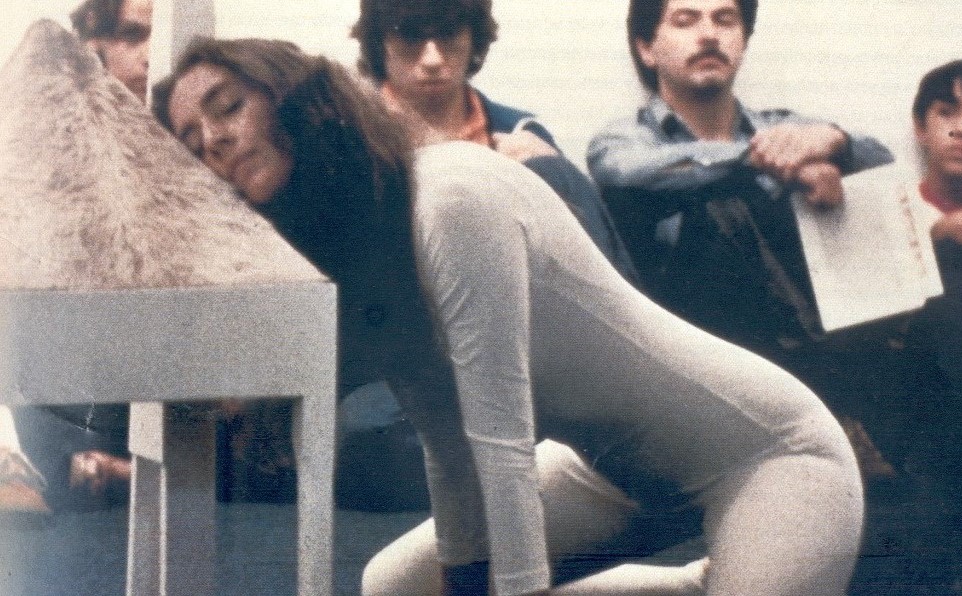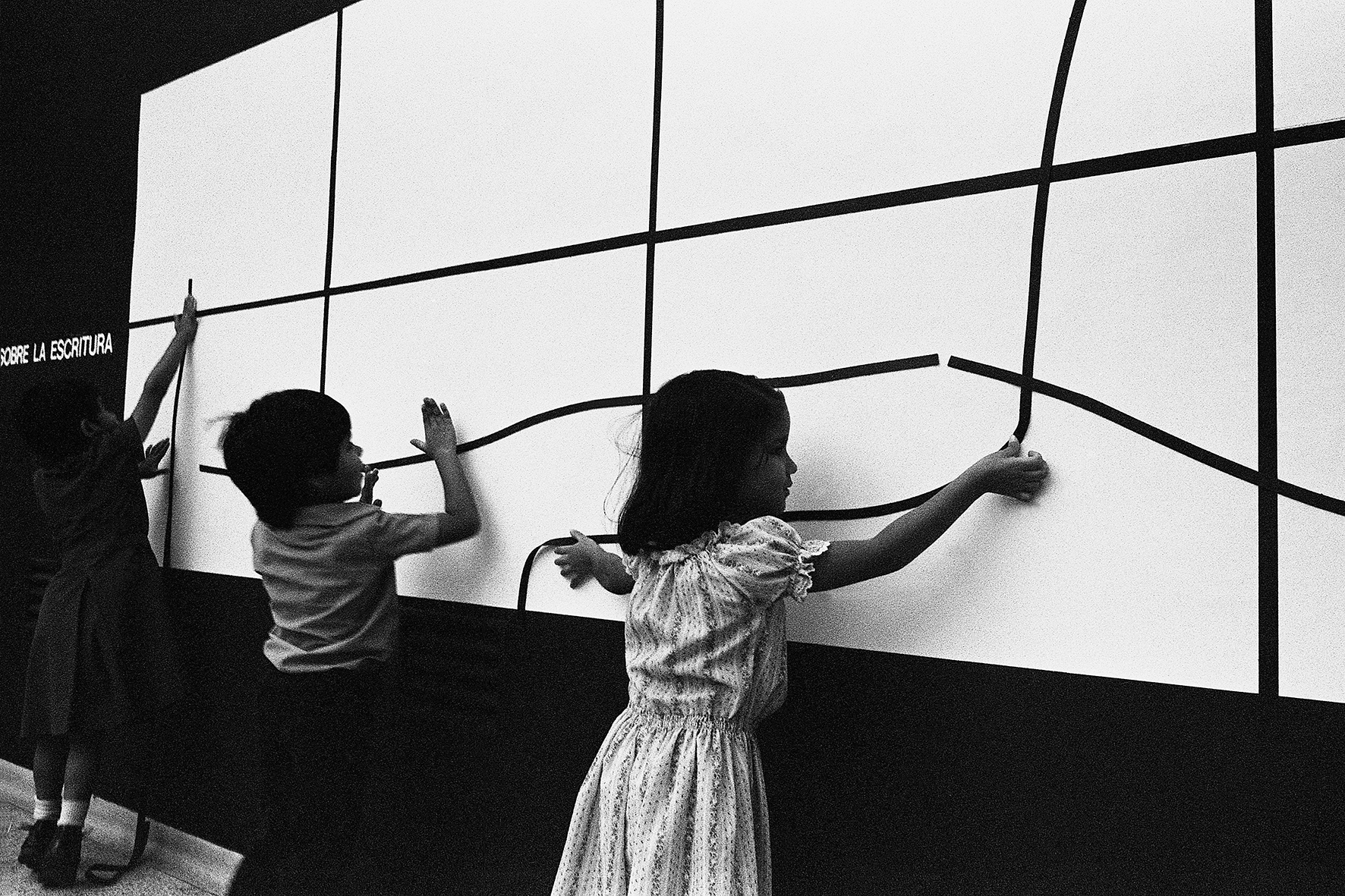La Escuela___: In the second half of the 20th century, Gego created a new world of possibilities for constructive language with her Reticuláreas. In her work, space, lines, and subject converge in unprecedented ways; how did these three elements relate to each other? What do you think made Gego unique as an artist?
A Solid Core of Reasoning
10/14/2022
with Ruth Auerbach
Gego (1912–1994) was a German-Venezuelan artist, architect, and designer who gained international recognition with her large-format spatial installations. She is considered one of the most representative artists of 20th-century abstraction in Latin America. Parallel to her artistic work, Gego developed a particular methodology in which she managed to combine the technical rigor of the Bauhaus heritage with the creative freedoms of art. This program was aimed at future architects and designers, among which was curator and researcher Ruth Auerbach. From Caracas, Venezuela, Ruth talks to LA ESCUELA___ about architecture, art, and the unique pedagogy of her peculiar teacher.
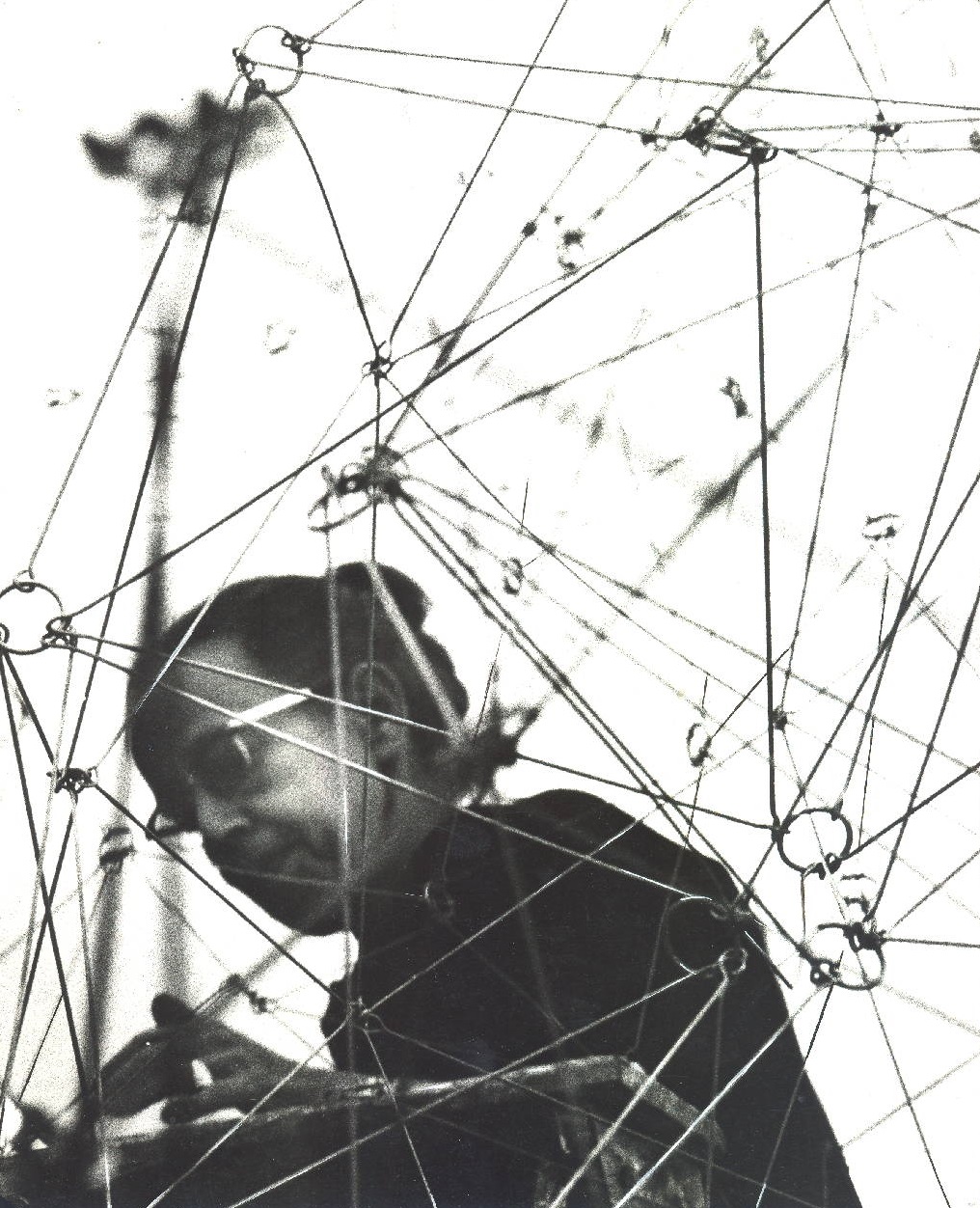
Ruth Auerbach: From these premises, Gego managed to develop the genesis of a unique creative universe, which is difficult to classify. Unlike other outstanding kinetic and constructive artists, she was trained as an architect-engineer, so for her, the disciplined and rigorous application of a working method in which concept, logic, and technique were attuned in perfect harmony with the expressive signs, gave way to achieving later freedoms, where the intuitive and the poetic allowed imagination to overflow. Gego did not pursue the seriality of fixed patterns, in her works, each triangle or square is different. For example, in the structural system of the Troncos [Trunks] and the Chorros [Streams], the nodes aren’t rigid; they have a degree of autonomy that allows their sides to move, creating a more organic and natural result.
In Gego, the study of three-dimensional geometry, of regular and semi-regular volumes and their interrelationships, as well as their endless constructive possibilities, derives from spatial vision and structural thinking. Likewise, the line and drawing as expressive elements that modify space in an intuitive search for the void as an event, would be fundamental notions for the development of her singular contributions to art. Gego studied geometry to capture an essence that she later instinctively challenged to attain the unpredictable. This is how her 1969 large Reticulárea installation managed to activate a spatial experience in which lines drew the void, creating a multidimensional perspective and an alternative mode of production to the hegemony of the modern grid.
Gego's name stands out among the twentieth-century Latin American artists whose works are characterized by their uniqueness, experimentalism, and contextual bond with the place where they are based. However, by 1974, Marta Traba referred to her as a "rare genius, surprisingly underestimated," alluding to the absence of "serious" monographs and articles on her work at the time. What led to Gego's presence on this historiographical margin of Venezuelan arts?
Marta Traba held an extremely critical view of the masters of geometric abstraction and the rise of kinetic art in the monumental context that the oil culture fostered in Venezuela, especially in urban spaces. Although her judgment might seem biased and ruthless, Gego was encouraged by unconditional critics and the Museo de Bellas Artes in Caracas (MBA). However, at the time, the context was still not ready to digest the fragile and particular nature of her aesthetic approaches, which differed from the prevailing constructivism. We must also bear in mind her condition as a woman in that creative universe. Gego, together with other remarkable artists of her generation, such as Mercedes Pardo and Elsa Gramcko, among many others, represent the distinctive figures who, through individual and solitary quests, persistently and sensitively challenged the foundations of modernity in the country.
We must also remember that Gego emigrated to Venezuela in 1939 and, until 1948, she worked on design and construction for other architects, before retiring with her partner, Gerd Leufert, to the coastal town of Tarmas until 1956. It is there that she makes her first artistic incursions: watercolors and landscapes. Her return to Caracas would mark the beginning of the assertive and silent unleashing of her singular creative career, unintendedly destined to shake the guidelines of constructive art. Simultaneously, she inaugurated an extensive cycle of pedagogical work based on experimentation.
And how does the leap from the "misunderstood" artist of the 1970s to her current international relevance occur?
Although Gego maintained professional and friendly relationships with outstanding national and international artists and participated with them in various group exhibitions, it was not until the first installation of Reticulárea, in 1969, at the Museo de Bellas Artes in Caracas, that she revealed her own prodigious language of connections with space. In 1977, the Museo de Arte Contemporáneo de Caracas organized a splendid anthological exhibition, accompanied by the first and fundamental monographic publication on her, with texts by Hanni Ossot and design by Álvaro Sotillo.
It was only in 2001 that the first extensive retrospective—Gego 1955-1990, curated by Iris Peruga—was exhibited at the Museo de Bellas Artes in Caracas. It was a posthumous show that received unusual attention. It astonished international museums and galleries, which have devoted themselves, from then on, to study the work in context, reframing her original proposal in the broad domain legitimized by the global sphere, to do credit to her unquestionable contribution to 20th-century art. From then on, there have been countless exhibitions and publications worldwide, as well as acquisitions, donations, and loans of her works to the most prestigious cultural institutions.

It is known that the presence of public art in Venezuela toward the end of the 20th century had a political character, and was dominated by kinetic art and geometric abstraction. In this landscape, Gego's enigmatic figure contrasts with her contemporaries in her ever so intimate, meticulous, "free" searches. How did Gego relate to the large-scale artistic interventions in the urban space?
Due to her training as an architect, her main motivation was achieving the optimal integration of the structures into the architectural event, not as a mere mimetic displacement of the artwork. Gego did not miss the opportunity, she took it as a challenge; in her way, she created numerous projects for urban spaces and public and private buildings, some of them have disappeared already, others were never built. Since her first sculptural installation integrated into the internal spaces of the Banco Industrial (1961), she continued to contribute over the decade with other integration projects, among them are Torre Cedíaz (1967), Flechas [Arrows] (1968), and—together with Leufert—the INCE Murals (1969). In 1972, she created Cuerdas [Strings], an environmental structure for the open spaces of the Parque Central urban complex.
The work creates surfaces of double curvature built with nylon ropes stretched over water mirrors that unfold suspended over four levels. Likewise, in 1974, she created an environmental net integrated by distorted square planes, suspended in the courtyard of Pasaje Concordia (a work currently dismantled), which she called Nubes [Clouds]. This confirms her unfulfilled dream of building enormous nets between skyscrapers, as evidenced in a 1969 sketch entitled Reticulárea Between Buildings II. Unafraid of monumentality, Gego designed the setting Cuadriláteros, 1982 [Quadrilaterals, 1982] for the La Hoyada station of the Caracas Metro: a square net of aluminum tubes that overlaps, in-between two levels, the structure of concrete beams.
Her training as an architect also manifested in the field of integral design, turning this knowledge into a pedagogical methodology that would unfold in her future professorships and workshops. Were there differences between Gego the artist and the teacher? Was her "unprejudiced and singular" personality somehow related to her artistic and teaching processes?
Certainly, the valuable educational work in the training of architects and designers in Venezuela carried out by Gego over two decades (1958-1977) remains a little-known academic activity of hers; however, it has managed to establish potential resonances affecting both recent generations of creators in Venezuela and also, increasingly, multiple studies and disciplines on a global scale. Her legacy transcends the formal to introduce a particular way of seeing, thinking, and doing. Both at the Faculty of Architecture of the Universidad Central de Venezuela (FAU-UCV) and the Instituto de Diseño de la Fundación Neumann - INCE [Neumann Foundation’s Design Institute], she introduced a distinctive awareness combined with a research methodology based on experimentation, ethics, subjectivity, rigor, and spontaneity.
Gego never separated her teaching practice from the personal study of her work. For her, architecture, art, and pedagogy constituted a solid core of reasoning and operative skills that reached even her vital space. The processes and findings of the classroom have also a place in her work. The explorations of volumes in space and the exchange of ideas with her students would foster the simultaneous development of her brilliant proposal. However, in her usual discretion, she didn´t speak much nor show us the results of her artistic practice. It was only in the intimacy of her home that she would eventually show us her latest creations to a small group of close friends.
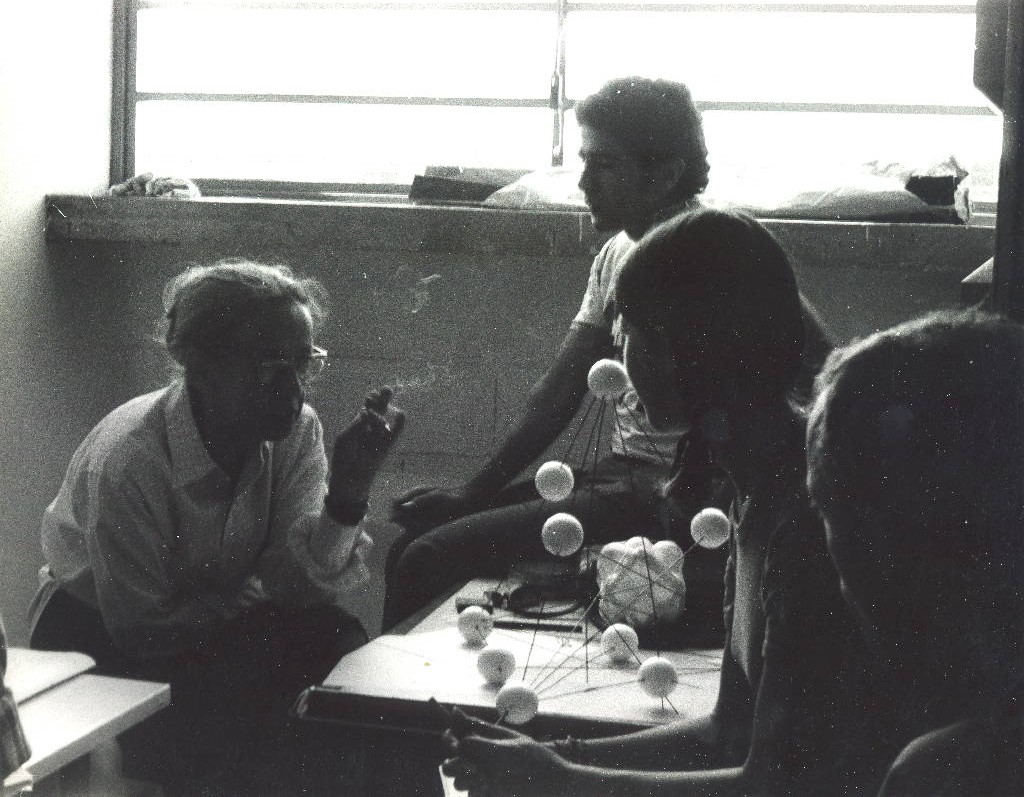

How did you meet Gego? Do you remember your first impressions of her? What do you recall from her class dynamics?
I met Gego in 1972 when I was a student and joined the Spatial Relations Seminar, which she taught at the Neumann Foundation's Design Institute between 1971 and 1977. With her small presence, poor hearing, and mixed accent, we were surprised to discover in her a great personality, endearing yet distant. From the genesis of the reticuláreas, around 1969, onwards, Gego became increasingly interested in geometry. She initiated a thorough study of spatial analytics through contemporary authors such as Keith Critchlow and Haresh Lalvani. Her attention focused on mathematics, on the analysis of reticular structures, on the tensegrity system, on the geodesic approaches of Richard Buckminster Fuller, and, particularly, on the transformation of polyhedra.
This cognitive universe gave rise to the "Gego Seminar," in which all members contributed with their explorations to the study of a chosen solid, which was to be shared among the members of the team. In a small classroom overflowing with models, drawings, and calculations, unprecedented research in our field was gradually gestated, which fundamentally enabled the speculative bases for her own creative inquiry, since Gego participated and was nourished in this workshop as another one of the students. To a small group of interested people, Gego provided us with the notions that define symmetry in spatiality, the nature of solids, mosaics or grids, and their combinations. Cuboctahedron, dymaxion, icosidodecahedron, symmetry axes, faces, vertex, edge, truncations, stellations, and so many other terms were the usual vocabulary with which we understood each other in this unique laboratory.
In Gego's 'workshop' methodology, the "open and organic orientation, grounded in basic principles of creative freedom" had an important role. How did these principles of freedom coexist with the mathematical rigor of her study of space?
Unlike the teaching method she applied in the workshops at the School of Architecture, where composing volumes resulted in formal solutions for design, in the Spatial Relations Seminar, there was no room for full creative expression. It was a rigorous inquiry based on the study of geometry and mathematics. The autonomy was in the free choice of the volume to be studied and how it would be presented to the group. The results of this scientific work were discussed in class. There was no imposition, it was like a research seedbed where ideas were integrated and results were contributed. Its conclusions later transcended into more creative works, such as three-dimensional package design and design projects for various constructions.
From this rigorous research carried out together with her students, Gego conceived new possibilities for reticular structures; in them, she discovered a new value in the unpredictable and integrated this into the stable data of the module. She appropriated the concept and conceived a structural linking system of her own, free and playful, by weaving segments of a constructive language to configure a poetics of space. Her Troncos [Trunks], Mallas [Meshes], and Esferas [Spheres] were born from the confluence of art and science. She defended and trained us in the idea of the need for calculation and discipline to later achieve the broadest freedoms expressed in her aesthetic project.
One might assume that, since Gego was trained in Stuttgart, she was familiar with the Bauhaus methodology from her student days. However, it was during her academic experience as a university professor that she delved deeper into this teaching method. How did Gego make use of the Bauhaus method in the classroom?
Gego completed her higher studies at the rigorous and traditional Technical University of Stuttgart, where she received her degree in 1938. It seems that, during her training, she did not have strong ties to the theories of the Bauhaus, which had been closed in 1932 because of its social orientation. Although she was indeed attracted by the liberal and modern ideas it promoted, the Bauhaus influence possibly came to her as a result of her visits to the avant-garde architecture of the Weissenhof district. It was only after leaving Germany that she became more closely linked to the ideology of this school, during her teaching experience at the Faculty of Architecture and Urbanism of the Universidad Central de Venezuela (UCV). There, she immersed herself in the Bauhaus teaching method, whose practice became the "filter" of the Basic Composition workshops. Throughout an entire decade, after 1957, the teaching experience and the student life revolved around her philosophy as the core of teaching, linked to a creative vision of architecture.
In these workshops, Gego emphasized the diversified social responsibility of the architect, but her aim was also to stimulate and train the creative possibilities or skills and visual sensibility, as well as delving into the importance of craftsmanship. The students’ exercises were carried out with constructivist teaching methods, achieving plastic results.
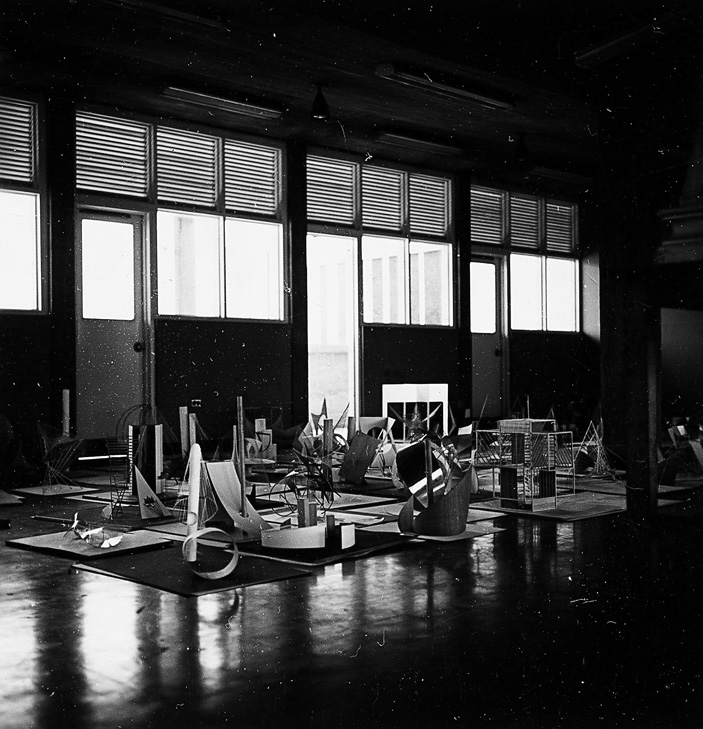
In UCV’s Faculty of Architecture and Urbanism, architecture as a "social art" is an important premise, even foundational in many ways. On the other hand, ethics and social responsibility come up repeatedly in Gego's lessons and testimonies. What are your memories from her classes concerning this topic?
In teaching conversations about the study program in her Basic Composition courses, as well as in her introductory talks, Gego insisted on her intention of bringing students closer to the problems, to the essence and fundamental sense of the trade. She reiterated the need to approach human situations and needs in order to achieve social goals. The "Gego Seminar" was oriented under a different concept, where the exploration and functional development of solid geometry and the systematic analysis that defines spatial geometry were shared. Ethics as a foundation of social responsibility, exercised through self-criticism, were essential factors in Gego for any activity she carried out.
As a researcher of Venezuelan art, why do you think Gego’s teaching facet is so little known?
Gego’s teaching experience, developed over two consecutive decades, was perhaps relegated because there was a greater interest in investigating in depth her creative process and the transcendence of her unique aesthetic approaches. However, I think it was after the 2001 retrospective and, especially, after the publication of the book Gego. Obra completa (1955-1990) [Gego. The Complete Works (1955-1990)], published two years later by Fundación Cisneros, that the scope of that experience was retrieved and disseminated. Fundación Gego made available to me all the documentary materials of unpublished archives linked to her pedagogical practice, from which I was able to complete the essay "Gego. La construcción de una didáctica” [Gego. Constructing a Didactics] which is one of the chapters of the volume.
Do you think it's possible to establish a "genealogy" between Gego's teaching and her influence on students who later became artists and designers?
Although I don’t think that Gego established a "school" from a didactic orientation aimed at architects and designers, through her classes, she managed to create a distinctive awareness and understanding in a devoted group of students who were captivated by her unconventional teaching and research methodology. It is those intangible aspects of her logic, related to ethics and subjectivity, that brought solid resonances in those who inherited from that particular pattern of learning. So, did Gego really exert a concrete influence, proposing a particular way of approaching the transparency of space as a multiplying effect of art based on the interconnection of systems and networks?
Much is argued about the legacy and influence of Gego's work on later generations of artists. Although these consequences will be considered in further research, we cannot fail to affirm that, precisely from the access to Gego's pedagogical dynamics at the Institute of Design, a small group of her students oriented their work exclusively toward art, developing a good part of their proposals from a geometric obsession and a reticular structure, following an alternative thinking and mode of production, thus distancing themselves from the hegemony of the modern grid. They potentially absorbed a multidimensional perspective of her principles. Eugenio Espinoza and Sigfredo Chacón—already established artists— developed a good part of their proposal from notions grasped from their time shared with Gego; Magdalena Fernández and Elías Crespín—of more recent generations—also propose a work that draws close resonances with Gego’s, based on the mathematical method, the linking mechanisms, and the way of occupying space from a line.
In your case, how does the figure of Gego manifest in your research and curatorial work? What lessons from Gego do you keep with you today? And lastly, as a graduate of the Neumann Institute, what other pedagogical experiences do you treasure?
Being a student of Gego was a privilege that left me with formal and technical contributions regarding the study of three-dimensional geometry and its application to integral design. But, today, I consider even more relevant the learning of meaningful ethical foundations for life, research, and the exchange of experiences with contemporary creators.
Likewise, perhaps intangible aspects of her discreet and willful personality were determining factors for me, a lesson that I try to continue in my practice: discipline and rigor as working methods and an individual analysis of the problem to develop a reasoned concept that later allows you to release your intuition in proposals of critical scope. Ultimately, her teachings led me to configure a spatial vision and structural understanding in my professional practice.
